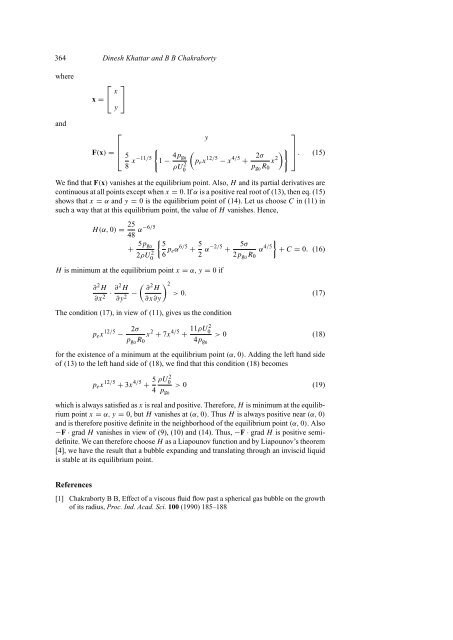Stability of a bubble expanding and translating through an inviscid ...
Stability of a bubble expanding and translating through an inviscid ...
Stability of a bubble expanding and translating through an inviscid ...
You also want an ePaper? Increase the reach of your titles
YUMPU automatically turns print PDFs into web optimized ePapers that Google loves.
364 Dinesh Khattar <strong><strong>an</strong>d</strong> B B Chakraborty<br />
where<br />
⎡<br />
x = ⎣ x ⎤<br />
⎦<br />
y<br />
<strong><strong>an</strong>d</strong><br />
F(x) =<br />
⎡<br />
⎢<br />
⎣<br />
y<br />
{<br />
5<br />
8 x−11/5 1 − 4p (<br />
g 0<br />
ρU0<br />
2 p e x 12/5 − x 4/5 +<br />
⎤<br />
2σ ) } ⎥<br />
x 2 ⎦ . (15)<br />
p g0 R 0<br />
We find that F(x) v<strong>an</strong>ishes at the equilibrium point. Also, H <strong><strong>an</strong>d</strong> its partial derivatives are<br />
continuous at all points except when x = 0. If α is a positive real root <strong>of</strong> (13), then eq. (15)<br />
shows that x = α <strong><strong>an</strong>d</strong> y = 0 is the equilibrium point <strong>of</strong> (14). Let us choose C in (11) in<br />
such a way that at this equilibrium point, the value <strong>of</strong> H v<strong>an</strong>ishes. Hence,<br />
H (α, 0) = 25<br />
48 α−6/5<br />
+ 5p g 0<br />
2ρU 2 0<br />
H is minimum at the equilibrium point x = α, y = 0if<br />
∂ 2 H<br />
∂x 2 · ∂2 H<br />
∂y 2<br />
{ 5<br />
6 p eα 6/5 + 5 2 α−2/5 + 5σ<br />
2p g0 R 0<br />
α 4/5 }<br />
+ C = 0. (16)<br />
( ∂ 2 ) 2 − H<br />
> 0. (17)<br />
∂x∂y<br />
The condition (17), in view <strong>of</strong> (11), gives us the condition<br />
p e x 12/5 −<br />
2σ x 2 + 7x 4/5 + 11ρU2 0<br />
> 0 (18)<br />
p g0 R 0 4p g0<br />
for the existence <strong>of</strong> a minimum at the equilibrium point (α, 0). Adding the left h<strong><strong>an</strong>d</strong> side<br />
<strong>of</strong> (13) to the left h<strong><strong>an</strong>d</strong> side <strong>of</strong> (18), we find that this condition (18) becomes<br />
p e x 12/5 + 3x 4/5 + 5 ρU0<br />
2 > 0 (19)<br />
4 p g0<br />
which is always satisfied as x is real <strong><strong>an</strong>d</strong> positive. Therefore, H is minimum at the equilibrium<br />
point x = α, y = 0, but H v<strong>an</strong>ishes at (α, 0). Thus H is always positive near (α, 0)<br />
<strong><strong>an</strong>d</strong> is therefore positive definite in the neighborhood <strong>of</strong> the equilibrium point (α, 0). Also<br />
−F · grad H v<strong>an</strong>ishes in view <strong>of</strong> (9), (10) <strong><strong>an</strong>d</strong> (14). Thus, −F · grad H is positive semidefinite.<br />
We c<strong>an</strong> therefore choose H as a Liapounov function <strong><strong>an</strong>d</strong> by Liapounov’s theorem<br />
[4], we have the result that a <strong>bubble</strong> <strong>exp<strong><strong>an</strong>d</strong>ing</strong> <strong><strong>an</strong>d</strong> <strong>tr<strong>an</strong>slating</strong> <strong>through</strong> <strong>an</strong> <strong>inviscid</strong> liquid<br />
is stable at its equilibrium point.<br />
References<br />
[1] Chakraborty B B, Effect <strong>of</strong> a viscous fluid flow past a spherical gas <strong>bubble</strong> on the growth<br />
<strong>of</strong> its radius, Proc. Ind. Acad. Sci. 100 (1990) 185–188
















